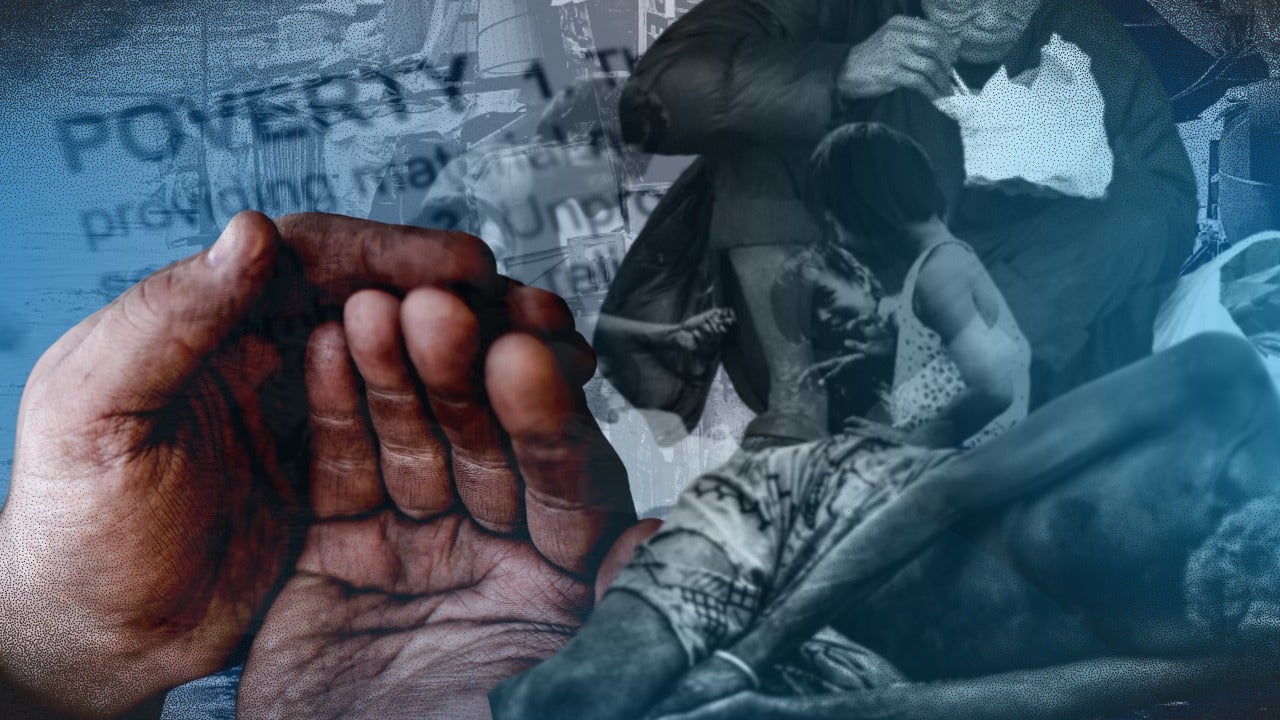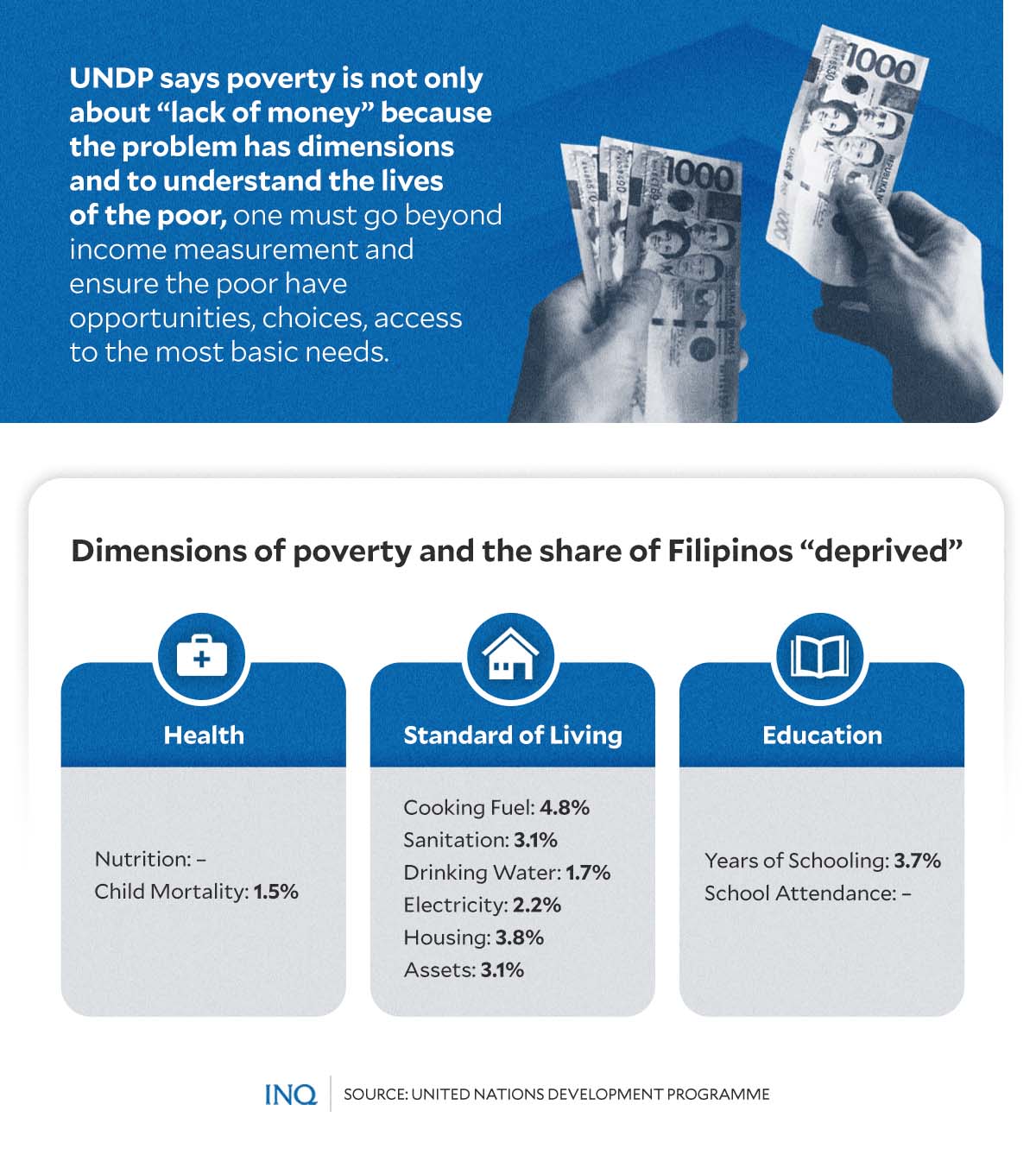Poverty: It’s not just about the money
MANILA, Philippines—What makes one poor?
The Philippine Statistics Authority (PSA) has set the poverty line in 2021 to P12,030 a month for a family of five, or P80.2 a day for an individual—a threshold described by the think tank Ibon Foundation as too low.
RELATED STORY: PH poverty: You’re not poor if you spend more than P18.62 per meal
With the threshold, 3.50 million families or 19.99 million were considered poor, with the poverty incidence rising to 18.1 percent from 16.7 percent in 2018, the PSA said as it released the latest poverty statistics last year.
READ: PH poverty incidence rises to 18.1% in 2021; 19.99 million Filipinos considered poor
Article continues after this advertisementBut the United Nations Development Programme (UNDP) said poverty is not only about “lack of money” because the problem has dimensions: “No two people experience poverty in the same way.”
Article continues after this advertisementThis was the reason that since 2010, it has partnered with the Oxford Poverty and Human Development Initiative (OPHDI) to present a new way to measure poverty—the Multidimensional Poverty Index (MPI).
According to the latest MPI, which was released on July 12, 5.8 percent of Filipinos were multidimensionally poor in 2022, or deprived in health, education and standard of living.
Deprived
The report said that measurements of multidimensional poverty attempt to offer clear priorities for addressing the decades-old problem, going beyond financial deprivation.
The MPI is the “only counting-based index that measures overlapping deprivations for more than 100 countries and 1,200 subnational regions and offers a key perspective on SDG 1, while encompassing indicators related to other SDGs.”
“No Poverty,” which is SDG 1, is one of the Sustainable Development Goals adopted by all UN member states in 2015, as part of the 2030 Agenda for Sustainable Development that set out a 15-year plan to achieve the SDGs.
The MPI “can be pictured as a stack of blocks, each of which represents a deprivation of a poor person.” The goal, UNDP and OPHDI said, is to “eliminate deprivation so the height of the stack declines.”
Based on the MPI, the share of the Philippines was lower than the 18.2 percent in all developing countries, but slightly higher than the 5.1 percent in the region—East Asia and the Pacific.
Dimensions of poverty
The share of multidimensionally poor in the Philippines has been steady at 5.8 percent, based on data compiled by INQUIRER.net from MPI editions for the years 2018, 2019, 2020, 2021, and 2022.
RELATED STORY: Ending poverty: ‘Real test of good governance’
Last year, 1.3 percent of the population was in severe multidimensional poverty, way higher than 0.9 percent in the region, but lower than 7.9 percent in developing countries.
According to the MPI, too, 7.3 percent of the Philippine population was also considered vulnerable, lower than 14.8 percent in developing countries and 14.4 percent in East Asia and the Pacific region.
Deprivations in health, education, and standard of living are identified by reviewing indicators—nutrition, child mortality, years of schooling, school attendance, access to cooking fuel, sanitation, drinking water, electricity, housing, and ownership of assets.
One is “MPI poor” if he or she is deprived of three or more weighted indicators.
The report said that in the Philippines, deprivation in health, education, and standard of living contributed 20.3 percent, 31 percent, and 48.7 percent to MPI.
Threshold
The latest MPI has set the poverty threshold to $2.15 a day, higher than the $1.90 a day in its previous editions, although the UNDP and OPHDI have consistently set income measures to $1.90 to $2.15.
Last year, three percent of Filipinos lived below the poverty line, which is P117.11 a day.
At least 25 countries successfully halved their MPI values within 15 years, showing that rapid progress is attainable. These include Cambodia, China, Congo, Honduras, India, Indonesia, Morocco, Serbia, and Vietnam.
India also saw a remarkable reduction in poverty, with 415 million people exiting poverty within just 15 years. Large numbers of people were lifted out of poverty, too, in China and Indonesia.
This, the UNDP and OPHDI said, demonstrated the feasibility of the SDG target of halving poverty according to national definitions within 15 years.
“Thus, it is crucial to consider context-specific multidimensional poverty indices that reflect national definitions of poverty, since the global MPI assesses multidimensional poverty with the same methodology,” it said.
Despite these encouraging trends, however, “the lack of post-pandemic data for most of the 110 countries covered by the global MPI restricts our understanding of the pandemic’s effects on poverty.”
READ: Basic wage in PH not even enough to meet poverty threshold, says think tank


